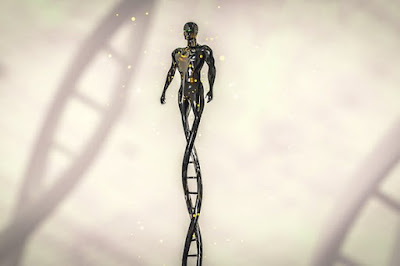 |
| Credit: Getty Images |
Topics: Biology, Ethics, Genetics, Star Trek
I read both novels and thoroughly enjoyed them immensely as the pure escapism Star Trek is. Perhaps this should be a metaphor for the ridiculousness of eugenics movements past, present or fantasy.
The Eugenics Wars: The Rise and Fall of Khan Noonien Singh is a two volume set of novels written by Greg Cox about the life of the fictional Star Trek character Khan Noonien Singh. He is often referred to as simply "Khan" in the Star Trek episode "Space Seed" and in the Star Trek movie Star Trek II: The Wrath of Khan.
The novels detail Khan's life until he leaves the Earth in the DY-100 sleeper ship SS Botany Bay later found by the Enterprise. They are written mostly in the perspective of the fictional characters Gary Seven and Roberta Lincoln, Gary Seven's partner. Both characters appear in the Star Trek episode "Assignment: Earth".
The first volume deals mostly with the Chrysalis Project, which was how Khan Noonien Singh and the rest of the superhumans were created. The genetically engineered "Children of Chrysalis" were mentally and physically superior to ordinary men and women. The scientists of Chrysalis desired for their creations to take over Earth. When Gary Seven and Roberta Lincoln begin to learn about this project, Roberta goes undercover as a scientist that wants to join the Chrysalis Project. The members of Chrysalis are convinced that she is who she claims to be, and she is allowed to join. Roberta heads out to an underground complex beneath the Thar Desert in India where the project is housed. Once there, Roberta begins to work out a way to stop the project.
Source: Wikipedia
A Chinese researcher recently disrupted the CCR5 gene, which builds a protein that acts as an entryway that HIV uses to gain entry to T-cells, allegedly creating the world’s first genetically engineered baby. Chinese officials moved swiftly to condemn the work, and rightly so. Gene-edited babies should probably always be prohibited, not because of fears of creating inequalities and advantaged “super babies,” but because of the reality that editing an embryo is not medically necessary. These modifications occur around conception rather than treating a suffering person—always involving introducing risk, and thus testing the age-old medical admonition of primum non nocere, meaning “first, to do no harm.”
Evolutionary dynamics are not trivial. In the 1970s, Lewontin and Hubby introduced the idea of balancing selection, which was extrapolated into principles that rare variants that contribute risk to various diseases may stick with us because of their compensatory benefit in contributing to heterogeneity or genetic variation within a population, or whereby risk variants contribute something positive in particular niches or contexts. Risk-causing genetic variants can also stay with us by “hitchhiking” along with beneficial ones that are positively selected for. One recent paper on schizophrenia suggests that risky mutations stay with us due to a process of background selection, whereby a lot of genetic variation is eliminated over time leaving risk variants in higher frequency. The important point is that genetic effects rarely are good or bad but depend on the shifting dynamics and backgrounds of other genetic variants.
Besides being relatively easy to use, there is more genetics information available to seek to exploit. Consider Danielle Posthuma’s work in Nature Genetics in 2017 tied 52 genes to human intelligence (though no single variant contributed more than a tiny fraction of a single percentage point to intelligence). Will college applicants begin stapling their 23 and Me results to their entrance applications? Will parents seek to engineer smarter kids in the lab? I want to convince you it is a fool’s errand. In fact, distributions of risk for mental disorders are also increasingly viewed to involve hundreds or thousands of gene variants. Thus, while the volition to improve our genomes is clearly evident by the ambition of scientists—and codified in the myths of Gattaca, Jurassic Park, Andromeda Strain and Mary Shelley’s Frankenstein—the reality is that genetic risks and advantages are not as straightforward as computer circuits.
The Myth of Genetic Superbabies, Jim Kozubek, Scientific American
Comments